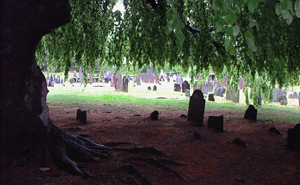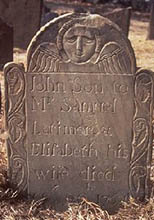NEW LONDON'S ANCIENTIST BURYING GROUND

Ye Antientest Burial Ground, New London, Connecticut.
Photo by Ralph Thayer, Wikipedia Commons.
"Of all the great burying grounds of eastern Connecticut, this is one of the most important, and certainly it is the one in greatest need of protection and care. Despite the air of neglect amid these surroundings, it is still a fine site enhanced by a gigantic copper beech that dominates the center of the graveyard (do not forget that amid the broken debris under this great tree there are hidden gravestones)."
In his comprehensive, illustrated guide to The Colonial Burying Grounds of Eastern Connecticut and the Men Who Made Them, first published in 1987, James A Slater began his description of New London's Ancient Burying Ground with this note of alarm. Fortunately, a community wide effort is now underway to restore it.
According to James Slater, "of all Connecticut's burying grounds, this may contain the greatest variety of different carving schools. The reasons are obvious. New London was an ancient port and reasonably wealthy. Stones were certainly shipped by sea from Newport and the Boston area and down the Connecticut and Thames rivers from Middletown, Portland, and Norwich. This variety was increased by the presence in the early and mid 1700's of Joshua Hempstead, who bought already designed stones and cut the letters on them."
A careful reading of early graveyards involves a knowledge of regional geology. Slater divides the 18th century gravestones east of the Connecticut River into four categories:
- Red and Brown Sandstones from the Connecticut River Valley
- Granite-schist "gray" stones from the inland heart of eastern Connecticut
- Slate stones from Boston and adjacent towns in eastern Massachusetts
- Slate stones from Newport, Rhode Island, and adjacent areas in the Narragansett River Basin.
Because of the town's wealth and location, "New London's ancient burying ground is a bewildering mixture of Boston and Newport slates, Connecticut River valley sandstones, and inland granites. Among the sandstone markers are several very early, large "tables" which can be seen in the picture above. Many of the sandstone markers are eroding because of their softness, and, according to Slater, merit serious study before the inscriptions - and even the stones themselves - are lost.
 Each gravestone is a work of art, and connoisseurs are able to identify not only the period but even the individual carver by the style of his (or her) lettering, typical choice of border designs and images. The Ancient Burying Ground contains the work of at least sixteen different gravestone carvers. Take a look at some of the most interesting stones on our special gallery page.
Each gravestone is a work of art, and connoisseurs are able to identify not only the period but even the individual carver by the style of his (or her) lettering, typical choice of border designs and images. The Ancient Burying Ground contains the work of at least sixteen different gravestone carvers. Take a look at some of the most interesting stones on our special gallery page.
Sources:
Interview with James A. Slater and further reference to his book, The Colonial Burying Grounds of Eastern Connecticut and the Men Who Made Them. (Hamden, Connecticut: Archon Books) 1987, 1996 (2nd edition). Dr. Slater (1920-2008) was Professor Emeritus of ecology and evolutionary biology at the University of Connecticut, and President of the Association for Gravestone Studies.
MORE READING ON NEW ENGLAND CEMETERIES, GRAVESTONES, AND CARVERS
Benes, Peter. The Masks of Orthdoxy: Folk Gravestone Carving in Plymouth County, Mass., 1689-1805. (Amherst: U of Mass Press), 1977.
Chase, Theodore and Laurel Gabel. Gravestone Chronicles: Some Eighteenth-Century New England Carvers and Their Work. (Boston: New England Historic Genealogical Society), 1990.
Ludwig, Allen I. Graven Images: New England Stonecarving and Its Symbols, 1650-1815. (Ann Arbor: Books on Demand).
And see also Markers VIII: Journal of the Association for Gravestone Studies – an issue devoted to the works of Ernest Caulfield, updated by James A. Slater.
